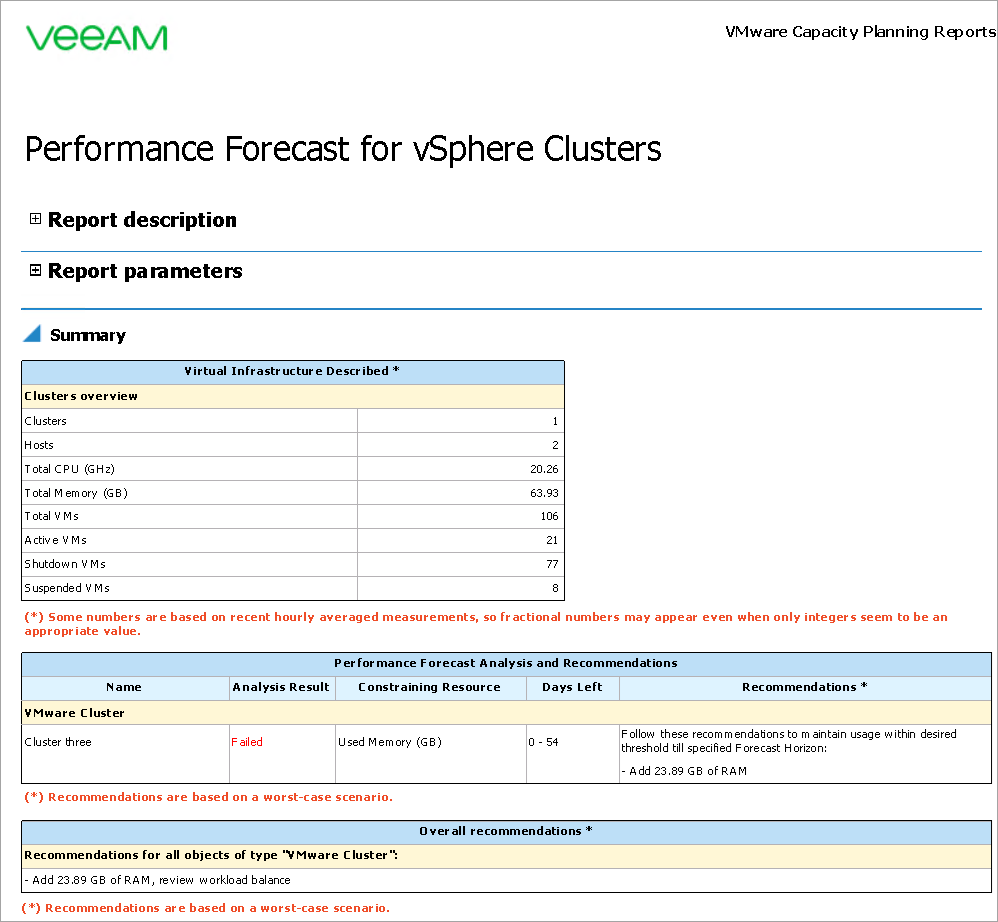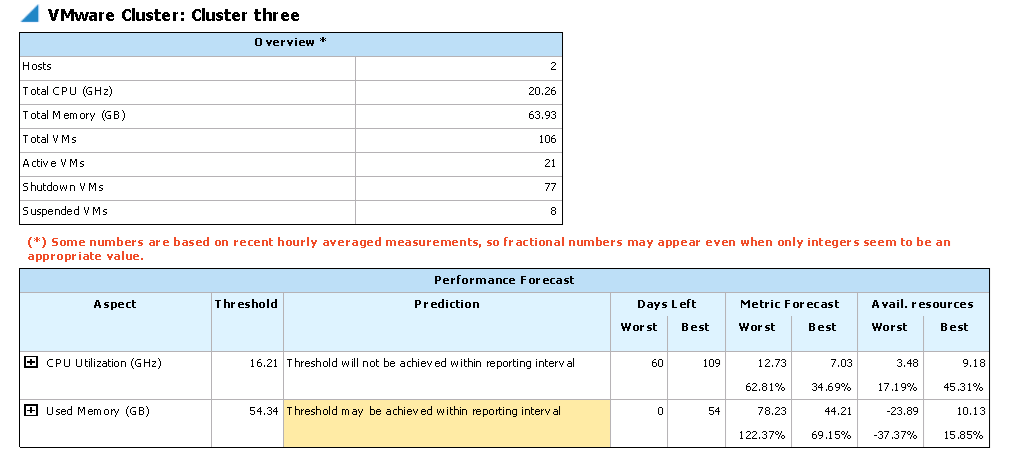Performance Forecast for vSphere Clusters
This report forecasts how many days remain before the level of CPU and memory resource utilization reaches the specified threshold values.
If one or more specified thresholds are forecasted to be breached, the report marks the cluster as problematic and lists constraining resources for it. The report also provides recommendations on appropriate resource allocation to prevent possible CPU and memory resource shortfalls in future.
Example Output
The report can be scoped at one or more vSphere clusters in your environment. In this example, the report forecasts the number of days left before the amount of used CPU reaches 80% and the amount of used memory reaches 85%.
To run this report:
- From the Performance Data From list, select a day that dates back 30 days from now.
- From the Forecast Horizon list, select a date 30 days from today to define the forecast period.
- In the Scope section, select the cluster for which you want to make a prediction.
- In the Threshold: CPU Usage (%) field, enter 80.
- In the Threshold: Used Memory (%) field, enter 85.
- In the Aspects to be Analyzed field, select both aspects.
- From the Show details list, select Collapse Charts.
- From the Mode list, select Show all results.
- Click Run to view the report.
The report will use historical performance data for the previous 30 days to analyze the CPU and memory utilization trend in the cluster. Next, it will apply the calculated performance trend to the forecast horizon and will detail how much CPU and memory resources will be available in future.
The Virtual Infrastructure Described table will provide an overview for the cluster included in the report scope: number of hosts, number of VMs (total, active, shutdown and suspended) and total CPU and memory usage values.
The Performance Forecast Analysis and Recommendations table will provide details and recommendations for the resource which utilization threshold will be breached first within the forecast period.
The Overall Recommendations table will provide recommendations for the cluster included in the report scope.
Further report details provide in-depth forecast information for the cluster.
The Virtual Infrastructure Described table will provide an overview for the cluster: number of hosts, number of VMs (total, active, shutdown and suspended) in the cluster and total CPU and memory usage values.
The Performance Forecast section will show a chart and a details table for each analyzed cluster resource.
The performance forecast charts will display the following types of data series for the analyzed data collection period: resource utilization trend and the 95% confidence interval for it, historical performance data for the data collection period, the threshold specified for the datastore resource and total datastore capacity.
The Performance Forecast table reveals whether the specified thresholds will be breached and details the following forecasted values (all values are provided for both the best-case and the worst-case scenarios):
- Days Left: number of days after which CPU and memory utilization thresholds will be breached
- Metric Forecast: predicted metric value at the end of the forecast period
- Available resources: amount of resources that will remain unused on the forecast horizon date (available resources, calculated as the difference between the threshold and the predicted resource usage)
In this example, the cluster is forecasted to run low on memory resources. In the worst-case scenario, the number of Days Left shows 0, which means that the amount of cluster memory may be already less than the threshold of 85%. In the best-case scenario, the number of days left before the memory utilization breaches the threshold is 54.
You can expand the table rows to open charts detailing actual CPU and memory utilization values, calculated utilization trend and its deviation, resource capacity and the threshold.
In this example, the report forecasts that CPU usage threshold will not be breached within the next 30 days.
Memory utilization threshold may be achieved within the next 30 days (in the worst-case scenario). The worst-case scenario is represented as the upper border of the yellow trend series on the chart. As seen from the example, the predicted worst-case memory usage value will be 122.37%. The predicted available memory usage value will be –37.37%, which means that the cluster will run out of memory already before the forecast horizon date.
It also possible that memory usage remains within the threshold (in the best-case scenario). The best-case scenario is represented as the lower border of the yellow trend series on the chart. As seen from the example, the predicted best-case memory usage in 54 days will be 69.15%.



